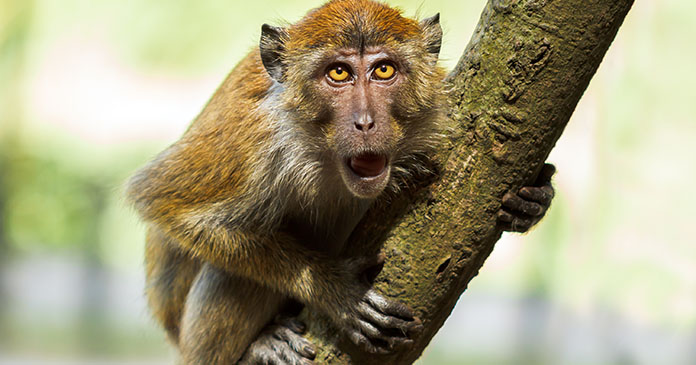Psychologists have long known that many people are prejudiced toward others based on group affiliations, be they racial, ethnic, religious, or even political. However, we know far less about why people are prone to prejudice in the first place. New research, using monkeys, suggests that the roots lie deep in our evolutionary past.
Yale graduate student Neha Mahajan, along with a team of psychologists, traveled to Cayo Santiago, an uninhabited island southeast of Puerto Rico also known as “Monkey Island,” in order to study the behavior of rhesus monkeys. Like humans, rhesus monkeys live in groups and form strong social bonds. The monkeys also tend to be wary of those they perceive as potentially threatening.
To figure out whether monkeys distinguish between insiders (i.e. those who belong to their group) and outsiders (i.e. those who don’t belong), the researchers measured the amount of time the monkeys stared at the photographed face of an insider versus outsider monkey. Across several experiments, they found that the monkeys stared longer at the faces of outsiders. This would suggest that monkeys were more wary of outsider faces.
However, it is also possible that outsiders simply evoke more curiosity. To rule this out, the researchers took advantage of the fact that male rhesus monkeys leave their childhood groups once they reach reproductive age. This allowed the researchers to pair familiar outsider faces (monkeys that had recently left the group) with less familiar insider faces (monkeys that had recently joined the group). When presented with these pairs, the monkeys continued to stare longer at outsider faces, even though they were more familiar with them. The monkeys were clearly making distinctions based on group membership.
Mahajan and her team also devised a method for figuring out whether the monkeys harbor negative feelings towards outsiders. They created a monkey-friendly version of the Implicit Association Test (IAT). For humans, the IAT is a computer-based task that measures unconscious biases by determining how quickly we associate different words (e.g. “good” and “bad”) with specific groups (e.g. faces of either African-Americans or European-Americans). If a person is quicker to associate “bad” with African-American faces compared to European-American faces, this suggests that he or she harbors an implicit bias against African-Americans.
For the rhesus monkeys, the researchers paired the photos of insider and outsider monkeys with either good things, such as fruits, or bad things, such as spiders. When an insider face was paired with fruit, or an outsider face was paired with a spider, the monkeys quickly lost interest. But when an insider face was paired with a spider, the monkeys looked longer at the photographs. Presumably, the monkeys found it confusing when something good was paired with something bad. This suggests that monkeys not only distinguish between insiders and outsiders, they associate insiders with good things and outsiders with bad things.
Overall, the results support an evolutionary basis for prejudice. Some researchers believe prejudice is unique to humans, since it seems to depend on complex thought processes. For example, past studies have found that people are likely to display prejudice after being reminded of their mortality, or after receiving a blow to their self-esteem. Since only humans are capable of contemplating their deaths or their self-image, these studies reinforce the view that only humans are capable of prejudice. But the behavior of the rhesus monkeys implies that our basic tendency to see the world in terms of “us” and “them” has ancient origins. Psychologist Catherine Cottrell at the University of Florida and her colleague Steven Neuberg at Arizona State University, argue that human prejudice evolved as a function of group living. Joining together in groups allowed humans to gain access to resources necessary for survival including food, water, and shelter. Groups also offered numerous advantages, such as making it easier to find a mate, care for children, and receive protection from others. However, group living also made us more wary of outsiders who could potentially harm the group by spreading disease, killing or hurting individuals, or stealing precious resources. To protect ourselves, we developed ways of identifying who belongs to our group and who doesn’t. Over time, this process of quickly evaluating others might have become so streamlined that it became unconscious.
Psychologists have long known that many of our prejudices operate automatically, without us even being aware of them. Most people, even those who care deeply about equality, show some level of prejudice towards other groups when tested using the IAT. Despite this overwhelming evidence that our brains are wired for bias, our society continues to think about prejudice as premeditated behavior. Our current laws against discrimination, as well as the majority of diversity training programs, assume that prejudice is overt and intentional. Rarely do we teach people about how automatic prejudices might taint their behavior toward others.
The fact that prejudice often occurs automatically doesn’t mean we can’t find ways of overcoming its negative effects. For example, there is evidence that when people are made aware of their automatic prejudices, they can self-correct. And when we are encouraged to take the perspective of an outsider, it reduces our automatic prejudice towards that person’s group.
Given that most of the difficult conflicts we face in the world today originate from clashes between social groups, it makes sense to devote time to understanding how to reduce our biases. But our evolutionary past suggests that in order to be effective, we may need to adopt a new approach. Often we focus more on political, historical, and cultural factors rather than the underlying patterns of thinking that fuel all conflicts. By taking into account the extent to which prejudice is deeply rooted in our brains, we have a better chance of coming up with long-term solutions that work with, rather than against, our natural tendencies.
Author: Daisy Grewal, PhD in social psychology from Yale University















